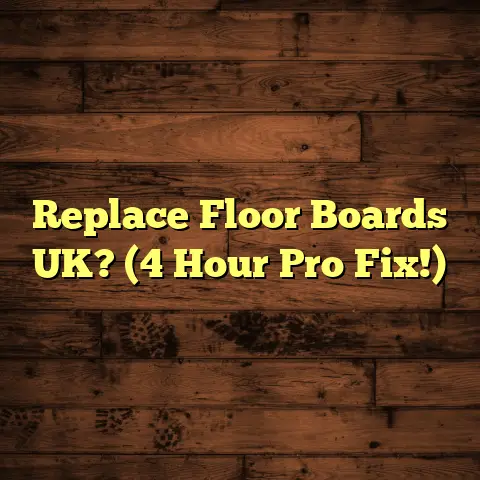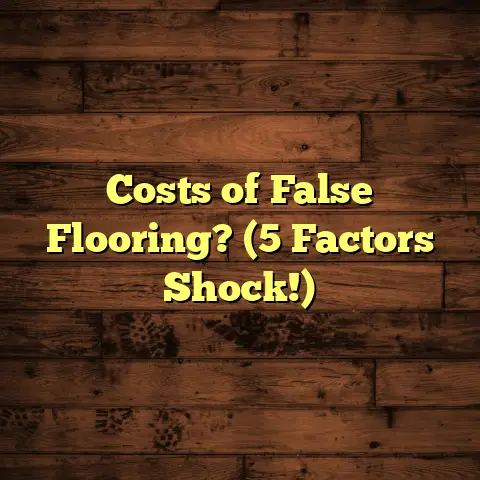Rejuvenate Bad For Wood? (2 HUGE Risks!)
It all started with a gleam in my eye and a bottle in my hand – Rejuvenate.
My wife and I bought our first house a few years back. It had beautiful, original hardwood floors. Or, at least, they had been beautiful.
Years of wear and tear had left them looking dull and lifeless. I was so excited to bring them back to their former glory!
I saw the ads, the before-and-after photos, the promises. Rejuvenate seemed like the perfect solution! A quick, easy way to restore the shine without sanding or refinishing.
I envisioned a weekend project, a bit of elbow grease, and BAM! Floors that looked brand new. I couldn’t wait to see my wife’s face.
I followed the instructions meticulously. Applied the Rejuvenate, and waited.
At first, I was thrilled! The floors were shiny, glossy, and seemed revived. My wife loved it.
But then, a few weeks later, I noticed something wasn’t right. A weird stickiness, a dull film, and discoloration.
My dream floors were turning into a nightmare! That’s when I realized I had a problem. A big problem.
That’s when I started digging deep. I needed to know what went wrong, and how to fix it. And what I found was alarming.
Turns out, Rejuvenate, and products like it, can pose some serious risks to your wood floors.
And I’m here to share what I learned with you!
Section 1: Understanding Rejuvenate
So, what exactly is Rejuvenate?
Simply put, it’s a polymer-based floor restorer. It’s designed to add a protective layer and shine to your floors.
The idea is appealing: avoid the hassle of sanding and refinishing, and just slap on a coat of this stuff for instant results.
It’s marketed as a quick and easy solution for homeowners and DIY enthusiasts looking to revive their tired-looking floors.
And it’s undeniably popular. You can find it in most big box stores, online, and even in some grocery stores.
The manufacturer claims it can restore shine, protect against scratches, and make your floors look new again.
Sounds great, right? Well, let’s take a look at some real-world experiences.
I’ve seen countless testimonials online, both good and bad. Some people swear by it, saying it saved their floors.
Others, like me, experienced the dark side.
Here are a few examples:
- Positive: “Rejuvenate made my floors look amazing! So easy to use!” – Jane D.
- Negative: “My floors are now sticky and attract dirt. I regret using this product.” – Tom S.
- Positive: “Great for a quick shine before guests arrive!” – Sarah L.
- Negative: “It ruined my floors! Now I have to pay for a professional refinishing.” – Michael B.
As you can see, experiences vary widely. But why? What’s going on beneath the surface?
Section 2: The Science Behind Wood Flooring
To understand the risks of Rejuvenate, we need a basic understanding of wood flooring itself.
Wood is a natural material, and its composition is complex.
It’s primarily made up of cellulose, hemicellulose, and lignin.
These components give wood its strength, structure, and unique characteristics.
There are two main categories of wood flooring: hardwood and softwood.
Hardwood comes from deciduous trees (like oak, maple, and cherry). Softwood comes from coniferous trees (like pine, fir, and spruce).
Hardwoods are generally denser and more durable than softwoods, making them a popular choice for flooring.
But even within hardwoods, there are variations in density and hardness.
The Janka hardness scale measures the resistance of wood to denting and wear.
For example, Brazilian Walnut (Ipe) has a Janka rating of 3680. While Eastern White Pine has a Janka rating of only 380. (Source: https://www.wood-database.com/janka-hardness/)
This means Ipe is significantly more resistant to scratches and dents than White Pine.
Wood is also hygroscopic, meaning it absorbs and releases moisture from the surrounding air.
This is why humidity and temperature play a crucial role in the longevity of wood floors.
Excessive moisture can cause wood to swell, warp, and even rot. While very dry conditions can cause it to shrink and crack.
Over time, wood floors naturally age. They fade, develop character, and show signs of wear. This is part of their charm!
But factors like UV exposure, foot traffic, and improper cleaning can accelerate this aging process.
Now, let’s talk about the chemical components of Rejuvenate.
While the exact formula is proprietary, it typically contains polymers, acrylics, and other additives.
These chemicals are designed to bond to the existing finish. They create a new, shiny layer on top of the wood.
The intended effect is to fill in scratches, even out the surface, and provide a protective barrier.
However, these chemicals can also interact with the existing finish and the wood itself in unpredictable ways.
And that’s where the problems begin.
Section 3: Risk 1 – Chemical Reactions
The first major risk associated with Rejuvenate is the potential for chemical reactions.
The ingredients in Rejuvenate can react negatively with the existing finish on your wood floors.
This can lead to a variety of problems, including:
- Discoloration: The Rejuvenate can cause the finish to turn yellow, orange, or even gray.
- Stickiness: The floor may become sticky, attracting dirt and dust.
- Uneven Finish: Streaks, blotches, and an uneven sheen can appear.
- Clouding: The floor can become cloudy or hazy, obscuring the natural grain of the wood.
These reactions are often caused by incompatibility between the Rejuvenate and the original finish.
For example, if your floors have an oil-based finish, applying a water-based product like Rejuvenate can cause adhesion problems.
The two layers simply don’t bond properly, leading to peeling, flaking, and other issues.
I’ve seen this happen firsthand. A client of mine had beautiful oak floors with a polyurethane finish. She used Rejuvenate to try and boost the shine.
A few weeks later, she called me in a panic. Her floors had turned a strange orange color, and they were incredibly sticky.
We had to completely sand down the floors and apply a new finish. It was a costly and time-consuming process.
Another common issue is the buildup of Rejuvenate over time. With each application, the product adds another layer of polymers to the floor.
This can create a thick, plastic-like coating that obscures the natural beauty of the wood.
It can also make the floor look unnatural and artificial.
Here’s a story from another homeowner:
“I used Rejuvenate every few months for a couple of years. At first, my floors looked great. But over time, they started to look dull and lifeless. The finish was thick and cloudy, and the wood grain was barely visible. I ended up having to refinish the entire floor to get rid of the buildup.” – Lisa M.
Expert opinions also highlight the dangers of improper use.
According to the National Wood Flooring Association (NWFA), “It is essential to identify the existing finish on your wood floors before applying any maintenance product. Using incompatible products can lead to adhesion problems, discoloration, and other damage.” (Source: https://www.nwfa.org/)
They also recommend consulting with a professional flooring contractor before using any new product on your wood floors.
Section 4: Risk 2 – Long-Term Damage
The second major risk is the potential for long-term damage to your wood floors.
Even if you don’t experience immediate problems, using Rejuvenate can create issues down the road.
One of the biggest concerns is the impact on future refinishing.
When it comes time to refinish your floors, the existing finish needs to be sanded down to bare wood.
However, the layer of Rejuvenate can make this process much more difficult.
The polymers in Rejuvenate can clog sandpaper, making it harder to achieve a smooth, even surface.
It can also contaminate the new finish, leading to adhesion problems and other issues.
I’ve encountered situations where the Rejuvenate layer was so thick and stubborn that it required specialized equipment and techniques to remove.
This can add significantly to the cost and time of the refinishing project.
Furthermore, using products like Rejuvenate can impact warranty claims with flooring manufacturers.
Most flooring warranties require you to use specific cleaning and maintenance products.
Using unapproved products can void your warranty, leaving you responsible for any repairs or replacements.
I spoke with a representative from a major flooring manufacturer. They told me that they often see warranty claims denied due to the use of products like Rejuvenate.
“Our warranties are very specific about the types of products that can be used on our floors,” they said. “Using unapproved products can damage the finish and void the warranty.”
Here’s another real-life example:
“I had a water leak that damaged my hardwood floors. I filed a warranty claim, but it was denied because I had been using Rejuvenate. The manufacturer said that the product had damaged the finish and voided the warranty. I ended up having to pay for the repairs out of pocket.” – David R.
Many homeowners regret using Rejuvenate after experiencing these long-term consequences.
They often have to take drastic steps to rectify the situation, such as:
- Professional Refinishing: Sanding down the floors and applying a new finish.
- Chemical Stripping: Using harsh chemicals to remove the Rejuvenate layer.
- Complete Replacement: Replacing the entire floor if the damage is too severe.
Unfortunately, in some cases, the damage is irreversible. The wood may be permanently stained or discolored, leaving you with no choice but to replace the flooring.
Conclusion
So, what have we learned?
Well, my little experiment with Rejuvenate taught me a valuable lesson.
Quick fixes aren’t always the best solution.
While Rejuvenate might seem like a convenient way to revive your wood floors, it can pose significant risks.
The potential for chemical reactions and long-term damage is real.
Before you reach for that bottle of Rejuvenate, take a moment to consider the potential consequences.
Think critically about the product claims, and weigh the risks against the benefits.
Remember, wood floors are a valuable investment. They deserve proper care and maintenance.
Instead of relying on quick fixes, consider these alternatives:
- Regular Cleaning: Use a pH-neutral wood floor cleaner and a microfiber mop.
- Professional Cleaning: Hire a professional to deep clean your floors periodically.
- Screening and Recoating: Apply a new coat of finish to refresh the shine.
- Refinishing: Sand down the floors and apply a new finish for a complete restoration.
And most importantly, consult with a qualified flooring contractor before using any new product on your wood floors.
They can help you identify the existing finish, assess the condition of your floors, and recommend the best course of action.
In the end, taking a proactive and informed approach to wood care is the best way to protect your investment and keep your floors looking beautiful for years to come.
Don’t let a quick fix turn into a long-term nightmare. Choose wisely, and your floors will thank you!





